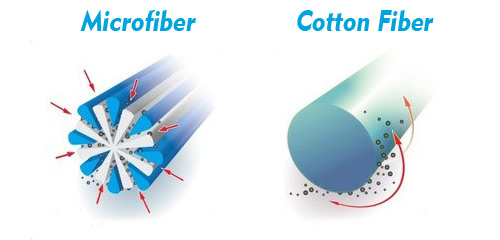While cotton is a natural fiber, microfiber is made from synthetic materials, typically a polyester-nylon blend. Microfiber is very fine — as much as 1/100th the diameter of a human hair — and about one-third the diameter of a cotton fiber.
Cotton is breathable, gentle enough that it won’t scratch surfaces and very inexpensive to purchase. Unfortunately, it has a lot of drawbacks: It pushes dirt and debris rather than picking it up, and it is made of organic materials that can harbor odor or bacteria. It also requires a break-in period to disperse the cotton seed oil, dries slowly and leaves lint behind.
Microfiber is highly absorbent (it can hold up to seven times its weight in water), making it very effective at actually picking up and removing soil from a surface. It also has a long lifespan when properly used and maintained, and is lint-free. Microfiber has only a few limitations — it comes with a much higher upfront cost than cotton, and it requires special laundering.
( Microfiber (or microfibre) is synthetic fiber finer than one denier or decitex/thread, having a diameter of less than ten micrometres. This is smaller than the diameter of a strand of silk (which is approximately one denier), which is itself about 1/5 the diameter of a human hair. The most common types of microfibers are made from polyesters, polyamides (e.g., nylon, Kevlar, Nomex, trogamide), or a conjugation of polyester, polyamide, and polypropylene. Microfiber is used to make mats, knits, and weaves for apparel, upholstery, industrial filters, and cleaning products. The shape, size, and combinations of synthetic fibers are selected for specific characteristics, including softness, toughness, absorption, water repellency, electrostatics, and filtering capabilities.
From Wikipedia)
Microfiber vs Cotton
 Reviewed by CREATIVE SCIENCES
on
August 18, 2018
Rating:
Reviewed by CREATIVE SCIENCES
on
August 18, 2018
Rating:
 Reviewed by CREATIVE SCIENCES
on
August 18, 2018
Rating:
Reviewed by CREATIVE SCIENCES
on
August 18, 2018
Rating:





